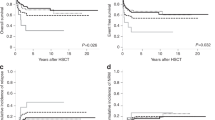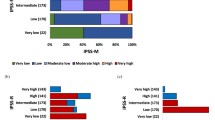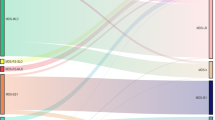Abstract
In the criteria of refractory cytopenia with multilineage dysplasia (RCMD) according to the WHO (World Health Organization) classification, the frequency threshold concerning dysplasia of each lineage was defined as 10%. To predict overall survival (OS) and leukemia-free survival (LFS) for patients with refractory anemia (RA) according to the French-American-British (FAB) classification, we investigated prognostic factors based on the morphological features of 100 Japanese and 87 German FAB-RA patients, excluding 5q-syndrome. In the univariate analysis of all patients, pseudo-Pelger–Huet anomalies ⩾10% (Pelger+), micromegakaryocytes ⩾10% (mMgk+), dysgranulopoiesis (dys G) ⩾10% and dysmegakaryopoiesis (dys Mgk) ⩾40% were unfavorable prognostic factors for OS and LFS (OS; P<0.001, LFS; P<0.001). The prognostic effects of the morphological features were similar in both Japanese and German patients. However, dys Mgk ⩾10% was not correlated with OS and LFS. In the multivariate analysis, mMgk+ and dys Mgk⩾40% were adverse prognostic factors for OS for all patients, and dys G ⩾10% and dys Mgk⩾40% were adverse prognostic factors for LFS for all patients. On the basis of the present analysis, we propose the following modified morphological criteria for RCMD. Modified RCMD should be defined as FAB-RA, excluding 5q-syndrome with dys G ⩾10%, dys Mgk⩾40% or mMgk+.
This is a preview of subscription content, access via your institution
Access options
Subscribe to this journal
Receive 12 print issues and online access
$259.00 per year
only $21.58 per issue
Buy this article
- Purchase on Springer Link
- Instant access to full article PDF
Prices may be subject to local taxes which are calculated during checkout



Similar content being viewed by others
References
Goasguen JE, Bennett JM . Classification and morphologic features of the myelodysplastic syndromes. Semin Oncol 1992; 19: 4–13.
Ganser A, Hoelzer D . Clinical course of myelodysplastic syndromes. Hematol Oncol Clin North Am 1992; 6: 607–617.
Koeffler HP . Introduction: myelodysplastic syndromes. Semin Hematol 1996; 33: 87–94.
Hofmann WK, Ottmann OG, Ganser A, Hoelzer D . Myelodysplastic syndromes: clinical features. Semin Hematol 1996; 33: 177–185.
Greenberg P, Cox C, LeBeau MM, Fenaux P, Morel P, Sanz G et al. International scoring system for evaluating prognosis in myelodysplastic syndromes. Blood 1997; 89: 2079–2088.
Jaffe ES, Harris NL, Stein H, Vardiman JW (eds.) World Health Organization Classification of Tumours: Pathology and Genetics of Tumours of Haematopoietic and Lymphoid Tissues. IARC Press: Lyon, France, 2001.
Germing U, Gattermann N, Strupp C, Aivado M, Aul C . Validation of the WHO proposals for a new classification of primary myelodysplastic syndromes: a retrospective analysis of 1600 patients. Leuk Res 2000; 24: 983–992.
Rosati S, Mick R, Xu F, Stonys E, Le Beau MM, Larson R et al. Refractory cytopenia with multilineage dysplasia: further characterization of an ‘unclassifiable’ myelodysplastic syndrome. Leukemia 1996; 10: 20–26.
Lorand-Metze I, Pinheiro MP, Ribeiro E, de Paula EV, Metze K . Factors influencing survival in myelodysplastic syndromes in a Brazilian population: comparison of FAB and WHO classifications. Leuk Res 2004; 28: 587–594.
Matsuda A, Jinnai I, Yagasaki F, Kusumoto S, Minamihisamatsu S, Honda S et al. Refractory anemia with severe dysplasia: clinical significance of morphological features in refractory anemia. Leukemia 1998; 12: 482–485.
Matsuda A, Jinnai I, Yagasaki F, Kusumoto S, Murohashi I, Bessho M et al. New system for assessing the prognosis of refractory anemia patients. Leukemia 1999; 13: 1727–1734.
Matsuda A, Germing U, Jinnai I, Misumi M, Kuendgen A, Knipp S et al. Difference in clinical features between Japanese and German patients with refractory anemia in myelodysplastic syndromes. Blood 2005; 106: 2633–2640.
Germing U, Gattermann N, Aivado M, Hildebrandt B, Aul C . Two types of acquired idiopathic sideroblastic anaemia (AISA): a time-tested distinction. Br J Haematol 2000; 108: 724–728.
Nosslinger T, Reisner R, Koller E, Gruner H, Tuchler H, Nowotny H et al. Myelodysplastic syndromes, from French-American-British to World Health Organization: comparison of classifications on 431 unselected patients from a single institution. Blood 2001; 98: 2935–2941.
Kuriyama K, Tomonaga M, Matsuo T, Ginnai I, Ichimaru M . Diagnostic significance of detecting pseudo-Pelger–Huet anomalies and micro-megakaryocytes in myelodysplastic syndrome. Br J Haematol 1986; 63: 665–669.
Acknowledgements
Supported in part by a Grant-in-Aid for Scientific Research from the Japan Society for the Promotion of Science (no. 16639013) (IJ) and Kompetenznetzwerk ‘Akute und Chronische Leukämien’ des Bundesforschungsministeriums.
Author information
Authors and Affiliations
Corresponding author
Rights and permissions
About this article
Cite this article
Matsuda, A., Germing, U., Jinnai, I. et al. Improvement of criteria for refractory cytopenia with multilineage dysplasia according to the WHO classification based on prognostic significance of morphological features in patients with refractory anemia according to the FAB classification. Leukemia 21, 678–686 (2007). https://doi.org/10.1038/sj.leu.2404571
Received:
Revised:
Accepted:
Published:
Issue Date:
DOI: https://doi.org/10.1038/sj.leu.2404571
Keywords
This article is cited by
-
The International Consensus Classification of myelodysplastic syndromes and related entities
Virchows Archiv (2023)
-
Comparison of the revised 4th (2016) and 5th (2022) editions of the World Health Organization classification of myelodysplastic neoplasms
Leukemia (2022)
-
Machine learning identifies the independent role of dysplasia in the prediction of response to chemotherapy in AML
Leukemia (2022)
-
Eltrombopag in Immune Thrombocytopenia, Aplastic Anemia, and Myelodysplastic Syndrome: From Megakaryopoiesis to Immunomodulation
Drugs (2019)
-
Nuances of Morphology in Myelodysplastic Diseases in the Age of Molecular Diagnostics
Current Hematologic Malignancy Reports (2017)



